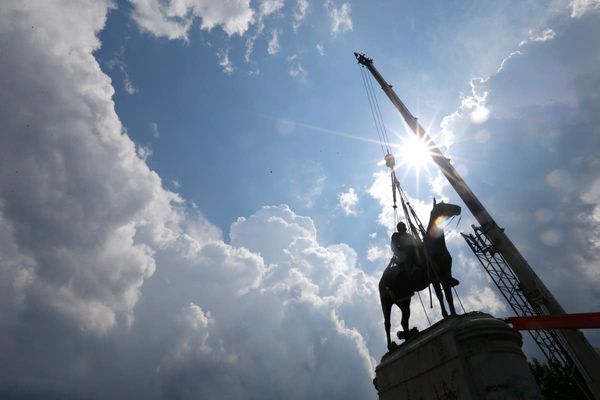
Looming over the sandstone steps of the Art Gallery of New South Wales, a giant spider is redirecting foot traffic. The giant spider, titled Maman, is one of the late French-American artist Louise Bourgeois’ most renowned – and most outsized – works, towering at almost 10m at its highest point and sprawling just as wide.
When I visit on the final day of installation, it is cordoned off – though at regular intervals, visitors peer through the gaps to gawp at the spindly creation within. People take photos from various angles in an effort to bypass the fence; others, circumnavigating the sculpture, end up down back alleys trying to find their way back.
This is the centrepiece of the AGNSW’s summer exhibition, which opens later this month: the most expansive survey of Bourgeois’ seven-decade career ever seen in the Asia Pacific, titled Has the Day Invaded the Night or Has the Night Invaded the Day? As its name suggests, the show presents a cascade of contradictions, none so clear as in Maman: an arachnid fashioned from bronze, steel and marble, and yet so delicate it seems to balance precariously on just eight needlepoints. There’s the rigidity of its material against its unruly, organic shape: metalwork striating each leg like muscles; a sac of eggs hanging from its centre, threatening to burst. If you look at it for long enough, you might swear it sways in the breeze – all 10 tonnes of its hulking frame.

And then there’s the spider’s innate duality: a creature both fearful and fearsome; beset with violent connotations yet meticulously considered in its work of weaving. In naming the work Maman, the artist pays homage to her own mother, also a weaver, who ran a tapestry restoration business with Bourgeois’ father in Paris. In horror of the spider, there is also affection. It puts the love in Lovecraftian.
“The mother must protect its young, the mother has to kill insects to feed its young,” says Philip Larratt-Smith, curator at New York’s Easton Foundation, which administers Bourgeois’ legacy. “Louise is taking something that, at least in western culture, is often seen in a negative way. And she’s turning it into a positive symbol of her mother.”
We’re standing at the forecourt of the AGNSW’s south building; metres away, a crew of installers is putting the final touches on Maman. There is a soft rattle of machinery, the hum of drilling; a final leg of the spider is secured to a heavy-duty bracket in the ground. When completed, it will appear as though Maman has simply erupted from the Earth – though it is safely locked into place just beneath.

There was discussion about housing the work indoors, Larratt-Smith says, “but very few spaces can accommodate the work, even in the contemporary art world”. Despite the impracticalities, Bourgeois’ gargantuan sculptures have magnetised the industry: a similarly large work titled Spider, produced in 1996, three years before Maman, went on to become the most expensive sculpture by a woman, breaking its own record when it sold for $32.8m this year.
Maman, too, has traversed the globe since first being shown in 2000 in the vaulting Turbine Hall at London’s Tate Modern. Together with its six identical iterations, it has appeared on the cobblestoned streets of La Havana Vieja, Cuba and has graced the facades of major institutions everywhere, including Paris’ Centre Pompidou, Tokyo’s Mori art museum, and Spain’s Guggenheim Bilbao. Most recently, in August, it stood guard outside Oslo’s Royal palace.

Maman was constructed in the late 90s when Bourgeois was living in New York; she worked with a local foundry, sending models and experiments back and forth. “Louise had terrible agoraphobia throughout her life,” Larratt-Smith says. “That kept her from being able to going to openings or shows [but] she worked with a team of fabricators who would bring a model and she would kick out a leg here, bend it this way, slowly work from there.”
Before its installation at the Tate, it was first assembled in full in Paterson, New Jersey, where Bourgeois had a longstanding relationship with a transport company. “It’s perfectly safe,” Larratt-Smith quickly disclaims. “But they wanted to do some tests to make sure they could have it in public, and not taped off.”
When Maman opens next week, visitors will be allowed to traverse the full length of its body. They may, if they wish, stand beneath the spider’s head and gaze upwards at its imposing scale. They may even find refuge within the spider’s wide embrace. “You feel contained and protected but you also feel this vastness,” Larratt-Smith says. “It’s like a child’s view of the world … the parent is huge, and the parent’s world is huge too.”
The Louise Bourgeois exhibition, Has the Day Invaded the Night or Has the Night Invaded the Day?, opens at the Art Gallery of NSW on Saturday 25 November







